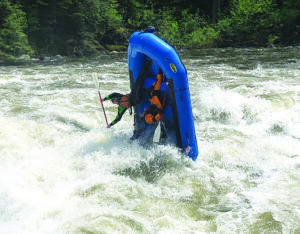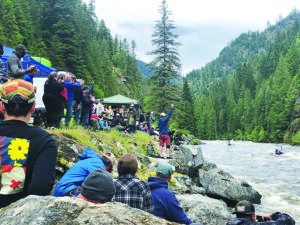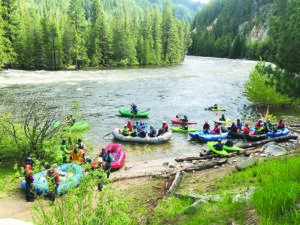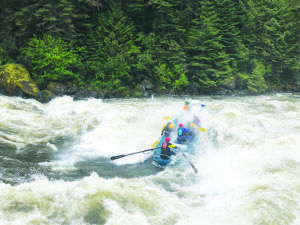
Lochsa River pulls fans from near and far
by Nathan Boddy
Two young women heave their raft onto the slide at the Fish Creek put-in on the Lochsa River. One of them waives exuberantly to a man she spots below on the river’s edge, calling out a name that isn’t his.
“Sorry!” She laughs when realizing her mistake. “I thought you were our friend!”

“I am your friend,” he calls back over the rim of his beer. Then he adds with a smile, “I’m everybody’s friend.”
And everybody does seem to be a friend. While the Lochsa River is entirely Idahoan, the visitors who take advantage of its brief, but tumultuous, runoff season come from all over the country. And while the water in the Lochsa may be frigid in late May, the spirits are warm and open as hundreds of adventure seekers queue up to send themselves down the River. In an explosion of frothing, white violence, they test their skills against rapids with such names as: Bloody Mary, the Grim Reaper, Killer Fang Falls, and Lochsa Falls itself.

Despite the popularity of the Lochsa River over the Memorial Day weekend, there is no single organizer or leader that claims control over the unofficial event. Instead, this normally quiet river valley draws the attention of ‘river people,’ regardless of state identity. Garth Levandoski is the Vice President of the Idaho Whitewater Association (IWA), a Boise-based non-profit safety and river advocacy organization. His group reserved one of the loops at the Wilderness Gateway Campground for its members over the weekend. In a barbecue smoke-filled pavilion, Garth and other IWA members prepare for a night of storytelling and highlight reels. He seems glad to see the group gaining steam after a slowdown during the Covid pandemic.

“The river community is a great community,” he says, adding that “nothing gets people in the river community like face to face interaction.”
Levandoski explains how the IWA formed in the wake of a proposal to dam Idaho’s Payette River in the 1980s, but stuck around to engage in everything from food drives, to life jacket donations and riverside cleanup. Levandoski says that “if there’s an issue about accessing a river, we can take that issue to the appropriate people to get that conversation started.” Ironically, many of the IWA’s efforts are targeted on rivers that many Bitterrooters could easily consider local as well, the Salmon and the Lochsa being examples.
All advocacy aside, it’s clear that the folks at IWA are just as passionate about enjoying the moment as they are thinking about the future. Levandoski laughs when asked what the best way to get down the river is.
“Upright?” he asks, then mentions that one group ran a portion of the river in an inflatable couch. “They didn’t do well,” he laughs.
All in all, however, the safety illustrated along the river during the weekend is admirably high. Christopher Noyes, with the Nez Perce Clearwater National Forest, says that he is unaware of any injury aside from bumps and bruises during the weekend. Part of that may be owing to the fact that the river is accessible by the adjacent highway for nearly all of its runnable stretches, and boaters are often able to scout their runs well in advance.
Ian Fodor-Davis, owner of Zoo Town Surfers of Missoula, points out other reasons why the Lochsa can be safely run. He says that it’s “the level of camaraderie, of family and help that you see down there. Everybody is watching out for everybody else. The level of safety is really high. You never see anybody on the water without a PFD and a helmet, doing the right thing.”
Fodor-Davis, who purchased Zoo Town Surfers earlier this year, has run the Lochsa hundreds of times and considers it one of his favorite rivers. He uses the example of Lochsa Falls, a class IV rapid at mile 114.1 of the highway which draws hundreds of river-edge onlookers due to its propensity to flip watercraft. “Even with the incredibly explosive, violent flips that happen in the falls, in general they’re pretty controllable after the fact. We would call it a ‘friendly swim’ in the whitewater world.” This is due to the fact that the rapid concludes with a very large wave train, but no rocks and obstructions that could pose a serious safety hazard. Furthermore, as Fodor-Davis points out, floaters often tackle the rapids in groups and designate downstream safety to collect swimmers when necessary.
“We encourage participation where it’s safe,” he says. “We love to get people on the water, people who are fit and healthy and excited for an adrenaline filled adventure.”
While Zoo Town Surfers was running commercially guided runs on the river, Fodor-Davis was quick to add that they were having fun, too. “It makes you feel small, but it also makes you feel really powerful because you are riding this thing that is so much more powerful than you are, yet you’re able to maintain some semblance of control. It’s more like a dance where you are not the leader but you are the follower.”
The season for the Lochsa is short, generally losing its steam by the end of June. Those interested in dipping a toe in with guided pros would want to move fast, and can learn more by visiting https://www.zootownsurfers.com.